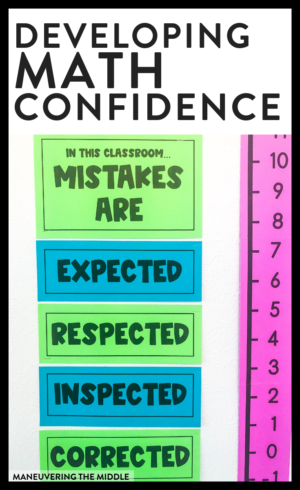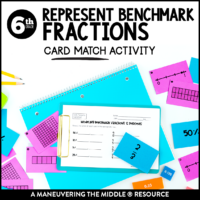You can see it on their face during a new lesson. It is obvious in the way they show their work on a page. Some students exhibit math confidence and other have yet to have it fostered. Some people have brains that think in numbers. If you are math teacher, you are likely one of them. Is developing math confidence within a student possible?
I believe the answer is yes.

DEVELOPING MATH CONFIDENCE
A lack of math confidence is displayed in a few common ways…the student who has always struggled with math, the one who has stage fright on tests, and the one who needs you to check each and every step before they go on. Sound familiar?
In my experience these students all need the same thing, someone to help develop math confidence. And how do you do such a thing? The same way a toddler learns to walk, the same way a kiddo learns to ride a bike, the same way you learn a new skill. You practice.
The tricky thing is that these students already have a bad taste in their mouth about it. They are coming with a negative experience or a defeatist mentality. Shoot, some will just tell you, “I’m not good at math”.
SMALL WINS
My number one suggestion for developing math confidence is to set your student up for success. Small wins. A student pastor often uses the phrase “stacking the deck in their favor”. Provide ample opportunities for them to be successful with the small things.
For me this played out most frequently in my math intervention class. This class was once a day for 45 minutes. Fifteen students who where in my on-level math classes would return back to me for 8th period. Here are some of the things I incorporated to help create those small wins.
Skill Practice
- Each day we took the same fraction, decimal, percent conversion quiz. I gave the same one for several days in a row and gave students more than ample time to finish. Slowly, we decreased the time and changed up the conversions. I kept a chart (not visible) and recorded their progress. They always wanted to see.
- We practiced our multiplication table. Over. And over.
- I used a set of rational number cards as a sponge activity and we regularly ordered them.
- We played memory with squares and square root cards.
- Throughout the week, we would use Marcy Cook centers to provide skill practice. Students liked that they could choose which one to work on and that once they got the hang of it there were 20 to practice.
These were all small wins, not because of the activity, but more so because it was repeated frequently. In five years of intervention classes, I never had a student that could convert between fractions, decimals, and percents fluidly on the first try. I did have many who were excellent at it by the end of the year.
Students who lack math confidence need regular and repeated practice, so that they begin to see those small wins. An intervention class is the perfect way to incorporate it.
AN ENCOURAGER
A win is always more exciting when there is someone to celebrate with. Often times that might be a fellow teammate, or a coach, or a parent. In the math classroom, it’s you, the teacher.
Students need and want to be have their accomplishments celebrated. Now in the middle school classroom, this is often “not cool” or “embarrassing” because it singles them out from the crowd. So, I warn that you must tread lightly.
A few simple ways to encourage:
- Provide genuine and specific feedback on paper. Sometimes it was a sticky note that I placed on their desk, sometimes a note on a returned assignment. Either way, it always brought about a smile.
- Point out the progress they have made. Students who lack math confidence tend to compare themselves to where they “should” be or where others are. Remind them often of the progress they have made. I used to compare math to learning a new sport, it takes a lot of time and practice.
- Find out where they excel. Are they a talented artist? Do they love reading? Maybe they are super interested in mechanics or sports or comic books. It doesn’t matter what “it” is, what matters is that they know that you know. Ask them about it, encourage them in that way.
- Acknowledge that they struggle. This might be controversial, since we tend to call intervention classes “Math Success” or “Power Math”, but I think students appreciate when you acknowledge that they struggle. Possibly, even share about something you are working towards.
- Praise them verbally. We often did this during our data talks when reflecting on their most recent benchmark assessment.
I recently started a cross training program, Camp Gladiator. I can count the number of times I have exercised in the past year on one hand. It was a struggle on day one. Actually, I pretty much couldn’t move. The instructor said something that really struck me, “the best way to get rid of the pain is to keep coming back.” I think this applies to students who are developing math confidence. It’s not easy. It might make your brain hurt. It doesn’t come quick. But if you keep coming back, you will improve.
Not only a math lesson, but a life lesson.
What ways do you develop math confidence within your students?






I give my students an opportunity to earn back half the points they missed on classwork assignments if they redo the problem correctly. They immediately redo it and hand me back the assignment. I also reward good work with stickers. I also remind them about how much more they know now than they did in the beginning of the year.
Those are great points, Diane! How do you manage keeping tracking of who is getting point back? I think that is a great idea.
Noelle, this is the first time I’ve visited your site and it’s so inspiring! I’m a second year teacher, and I’ve really loved teaching 6th grade math. I have created a document I call Test Corrections, and it’s entirely optional but highly encouraged after each Chapter Test. I keep the stack in the same place all year so that students know exactly where to go to find them.
After each test, students can complete the Test Corrections in order to analyze their errors and correct them. If they correct every problem they initially missed, I average a 100% score with their first attempt. I still reference their struggles for interventions, but at least a test score won’t ruin their grade/confidence. In fact, I work with them after the first test of the year, modeling my expectations and asking students to share mistakes with the class so that all students understand what it means to analyze their errors and make corrections. It requires students to use math vocabulary to describe where they went wrong, and I won’t accept answers such as, “I didn’t understand but now I do.” They must be specific, and they must show their work proving that they corrected it. This gets rid of students requesting retakes, and having to manage that, and I’ve found that throughout the year students get more comfortable sharing their errors and allowing the class to analyze them together. I essentially collect the tests twice; once to grade it and once to grade their corrections. Just wanted to share! I’d be happy to email you the document; you could probably make it more appealing!!
Thanks for all your blog has to offer,
Natalie
Hi Natalie, thanks so much for stopping by! I am glad you enjoyed the site. 🙂 Yes, test corrections, such a great idea! I didn’t event think about how that promotes confidence because students are able to give it another shot and show what they have learned. It sounds like you have a great system! Thanks for the wonderful thought.
Hello,
I would love to have your test correction document. Please send to thomassoncara@gmail.com.
Thanks!
Hi Cara! At this time, I don’t have one available, but I will let you know as soon as I do. Thanks!
I think the test corrections page is genius! I can picture it with 12 boxes – basically room to re-work the problem. I, too, love your blog and have been going through each post one by one.
Thanks Suzanne! I am so glad you are finding it helpful. Let me know how the test corrections work out for you!
Love your blogs. So much good information.
I also use a test correction sheet, but I don’t change the test grade. Students rework the problem and explain their errors. This could be counted as a daily grade or possibly even a quiz grade. I guess it depends on whether the corrections are done in class or at home. I send mine home and am fine with them getting help from someone. They can also come to me to help them understand and complete corrections. Test grades would be artificially inflated if changed after all this help.
That is an interesting point. I always required students to get help, so that weren’t just adding gaps to their learning. Do you allow them to retest, so that their grade reflects their new learning?
Hi Noelle,
Thank you for all of your posts! Math confidence is something I am focusing on with my students this year because I saw how detrimental it was for some of my students last year (they wouldn’t even try a problem because they thought they couldn’t do it!). I plan to rework my 8th grade intervention lab to focus more on basic skills that they need or are lacking.
Have you ever connected with parents about a student’s math confidence and had them support the student more at home?
Hi Erica! Totally! Parents can play such a valuable role in encouraging their child, as well as teaching them to persevere. If you are going to send something home, then I would suggest making it easy to implement and providing a key for parents. Sometimes it has been a while since they have used those math skills. 🙂